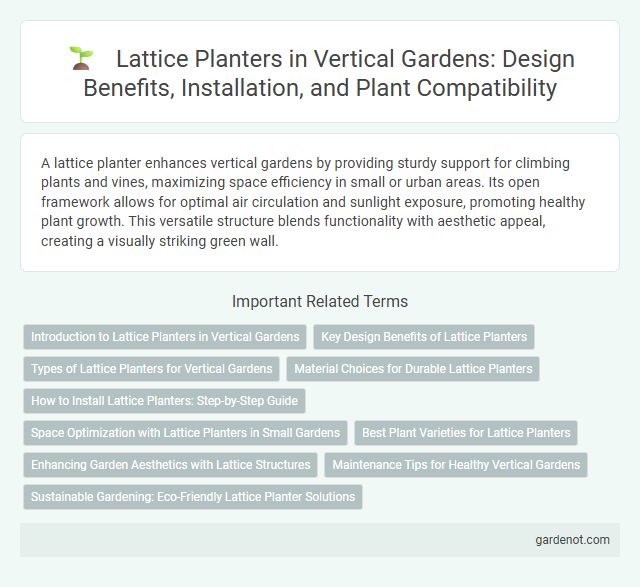A lattice planter enhances vertical gardens by providing sturdy support for climbing plants and vines, maximizing space efficiency in small or urban areas. Its open framework allows for optimal air circulation and sunlight exposure, promoting healthy plant growth. This versatile structure blends functionality with aesthetic appeal, creating a visually striking green wall.
Introduction to Lattice Planters in Vertical Gardens
Lattice planters are versatile structures designed to support climbing plants and maximize vertical gardening space by providing a stable framework for vines and creepers. Constructed from materials like wood, metal, or plastic, these planters enhance plant growth while improving air circulation and sunlight exposure. Ideal for urban gardens, lattice planters enable efficient use of limited areas, promoting aesthetic appeal and greenery in compact environments.
Key Design Benefits of Lattice Planters
Lattice planters optimize vertical gardening by providing structured support that enhances plant growth and maximizes space efficiency. Their open-grid design ensures superior air circulation and sunlight exposure, promoting healthier root systems and vibrant foliage. Durable materials used in lattice planters contribute to long-lasting performance, making them ideal for both indoor and outdoor vertical garden installations.
Types of Lattice Planters for Vertical Gardens
Lattice planters for vertical gardens come in various types, including wooden, metal, and plastic lattices, each offering distinct durability and aesthetic appeal. Wooden lattices provide a natural, rustic look and are often treated for weather resistance, while metal lattices offer sturdy support and modern design options, typically made from materials like wrought iron or aluminum. Plastic lattices are lightweight, low-maintenance, and available in diverse colors and patterns, making them ideal for indoor or shaded vertical garden spaces.
Material Choices for Durable Lattice Planters
Lattice planters for vertical gardens are commonly crafted from weather-resistant materials such as cedar wood, PVC, and powder-coated metal to ensure durability and longevity. Cedar wood offers natural resistance to rot and insects, making it ideal for outdoor use, while PVC provides a lightweight, waterproof option that won't warp or crack. Powder-coated metal lattice planters combine strength with rust protection, supporting heavy plant loads and withstanding various weather conditions.
How to Install Lattice Planters: Step-by-Step Guide
Install lattice planters by first selecting a sturdy, level wall or fence to support the structure. Secure the lattice panel using corrosion-resistant screws or hooks, ensuring proper spacing for plant growth and airflow. Finally, attach planter boxes or pots to the lattice, filling them with appropriate soil and plants suitable for vertical gardening.
Space Optimization with Lattice Planters in Small Gardens
Lattice planters maximize space utilization in small gardens by allowing vertical growth of plants, effectively increasing planting area without expanding the garden footprint. Their structure supports climbing plants and vines, enhancing greenery while maintaining order and accessibility. This vertical arrangement promotes better air circulation and sunlight exposure, improving plant health in compact urban environments.
Best Plant Varieties for Lattice Planters
Lattice planters thrive with climbing plants like English ivy, jasmine, and clematis that naturally weave through the grid for optimal coverage. Compact vegetables such as cherry tomatoes and snap peas benefit from vertical support while maximizing space in lattice planters. Herbs like thyme and oregano also adapt well, using the lattice structure for partial support and enhanced air circulation essential for healthy growth.
Enhancing Garden Aesthetics with Lattice Structures
Lattice planters elevate garden aesthetics by providing a visually appealing framework that supports climbing plants and vines. These structures create vertical interest while maximizing space efficiency, ideal for small gardens or urban balconies. Their geometric patterns add texture and depth, transforming any garden into a lush, dynamic environment.
Maintenance Tips for Healthy Vertical Gardens
Regularly inspect lattice planters for adequate drainage to prevent waterlogging and root rot in vertical gardens. Prune climbing plants frequently to ensure healthy growth and prevent overcrowding on the lattice structure. Clean the lattice surface periodically to remove debris and algae, promoting better air circulation and plant health.
Sustainable Gardening: Eco-Friendly Lattice Planter Solutions
Lattice planters crafted from recycled materials promote sustainable gardening by reducing waste and minimizing environmental impact. These eco-friendly lattice structures support vertical growth, optimizing space while conserving water through improved drainage and aeration. Incorporating biodegradable or sustainably sourced wood enhances soil health and contributes to a greener, more efficient garden ecosystem.
Lattice planter Infographic

 gardenot.com
gardenot.com